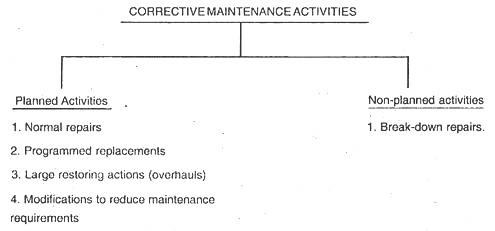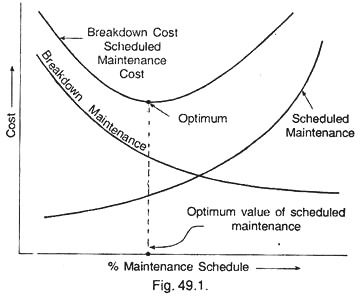After reading this article you will learn about:- 1. Types of Preventive Maintenance 2. Elements of Preventive Maintenance 3. Advantages 4. Requirements 5. Economics.
Types of Preventive Maintenance:
1. Corrective Maintenance:
Although this is broadly a preventive maintenance, this term is gaining importance. While carrying out repairs on a machine, either some minor modification work is done so that it may work little better than it was working before break-down, or some remedial action is introduced in such a way that it does not happen again, such works fall under corrective maintenance.
Whereas Preventive maintenance is responsible for cleaning the equipment, lubrication to prevent wear, programmed replacement and also indirectly deals with condition monitoring, failure statistics, and adjustments to limit wear. Corrective maintenance deals with normal repairs, programmed replacements, modifications to reduce requirements of maintenance and overhauls in addition to break-down repairs.
2. Predictive or Condition Based Maintenance:
This is also used along with preventive maintenance. In this system, health of the equipment is regularly monitored and recorded in the form of mechanical vibrations, noise, acoustic, thermal emissions; changes in chemical compositions, smell, pressure, relative displacement etc. This helps in diagnosis and detection of faults, if any. Vibrations and noise are most valuable signals.
Condition monitoring can be applied in following three ways:
(a) Qualitative checks based on look, sound and feel, through simple inspection.
(b) Condition checking by measuring some parameters regularly.
(c) Trend monitoring by making measurements and plotting them in order to detect gradual departure from a norm.
Elements of Preventive Maintenance:
Following are some of the important functions of the preventive maintenance programme:
1. Inspection or checkups.
2. Lubrication.
3. Planning and scheduling.
4. Records and analysis.
5. Training of maintenance staff.
6. Storage of spare parts.
1. Inspection or Check-Ups:
Inspection is an essential function of the preventive maintenance programme. Crews kept for this purpose should be well-trained. These crews carry out both the external and internal inspection.
External inspection means to watch for and detect defects from abnormal sound, vibration, heat, smoke etc., when machine is in operation, while internal inspection means inspection of internal parts, such as gears, bushes, bearings, tolerances in the parts etc., during the period when the machine is under planned shutdowns.
Frequency of inspection should be decided very carefully, as too less inspection may cause breakdown, as defects could not be traced out and rectified immediately, while too much inspection means wastage of machine time and labour productivity. Hence, frequency should be decided on the basis of past experiences and the scheduled programme for inspection is chalked out.
For the purpose of inspection, machines can be categorised as:
(i) Important Machines:
These are those machines which can disrupt whole of the production, are delicate and require much time for the repair. More stress should be given for the inspection of these machines and schedule for inspection, cleaning, lubrication, should be adhered to rigidly.
(ii) Ordinary Machines:
Frequency of inspection can be kept as low as they do not effect the production considerably.
2. Lubrication:
Mechanical components like gears, bearings, bushes and other friction surfaces etc., give good performance for long periods, when they are systematically lubricated. Systematic lubrication means the application of right type of lubricant at the right time, at right place and in right quantity. For lubrication, a schedule should be prepared and followed strictly.
3. Planning and Scheduling:
Every preventive maintenance work should be pre-planned in detail on the basis of the analysis done on the past records. A scheduled programme thus prepared should be followed strictly. Thus programme should be in detail specifying the points requiring daily, weekly, monthly, half yearly or yearly attention.
4. Records and Analysis:
Good record keeping is essential for good preventive maintenance, as it helps in forecasting maintenance.
For the purpose following records are generally maintained:
(i) Operational manual,
(ii) Maintenance Instruction manual,
(iii) History cards and History Registers,
(iv) Spares Procurement Register,
(v) Inspection Register,
(vi) Log books,
(vii) Defects Register etc.
With the help of these records possible cause for major repetitive failures can be examined and rectified so as not to repeat so early.
These records help the Plant Engineer to take so many decisions in the plant.
The analysis made on the basis of these records help in:
(i) Preventing defects rather than rectifying after breakdowns.
(ii) Knowing the machines reliability and thus helps in production planning.
(iii) Deciding life of the machine.
(iv) Forecasting defects and planning to rectify them before the failure occurs.
(v) Frequency of inspection and check-ups.
(vi) Deciding for the purchase of a machine, which may suit best, on the basis of past experience?
In spite of best inspection and other measures, failures are bound to occur but they can be reduced to large extent.
One example of preventive maintenance planning on the basis of records is being given hereunder:
A bearing of a machine had gone out of order after 800 hours of its running from the erection of this machine and second time after 1500 hours from the erection.
Then preventive maintenance need be planned to change its bearing after 600 hours or so, of running; as from the past records it may become out of order between 600 to 800 hours. Thus it may be checked on such date when it has run for about 600 hours and such time when it may not have any urgent work or is supposed to remain idle during that period.
5. Training of Maintenance Personnel:
For the success of preventive maintenance a sound training is essential for the maintenance personnel. Hence the technicians and supervisors are trained to carry out maintenance, inspection and repairs in a systematic way.
6. Storage of Spare Parts:
Sometimes machine remains idle for want of spare parts for considerable time and thus it affects considerable loss of production. Hence it is essential to keep the spare parts so as to avoid loss of production.
But the judgement and experience of high order is required for deciding the number of such parts, as storage of a large number of parts of will mean blocking of capital. The level of spare parts must be determined by considering different factors such as source of supply, delivery period and availability of that spare part in the market.
Standardisation will help to reduce the spare parts inventory and will also help in specialisation of maintenance of particular type of machine.
Advantages of Preventive Maintenance:
Following are some of the important advantages of efficiently planned and well executed preventive maintenance programme:
(i) Reduction in production downtime.
(ii) Lesser overtime pay for maintenance personnel.
(iii) Lesser number of standby equipment, lesser spare parts are needed to store at all time.
(iv) Less expenditure on repairs.
(v) Due to planned spare parts replacement, lesser spare parts are needed to store at all time.
(vi) Greater safety to employees because of reduced breakdowns.
Requirements for Good Preventive Maintenance:
For achieving preventive maintenance of high order, following are some of the essential requirements:
1. Good supervision of maintenance department.
2. Proper control of work i.e. priority be fixed with care and after consultation with production engineering department.
3. Correct, clear and detailed instructions be given to the maintenance crew and to the operators.
4. Operators should be well-trained.
5. A good lubrication record should be chalked out.
6. Proper maintenance record should be chalked out.
7. Adequate stock of spares should always be kept.
8. Surroundings should be dust free and clean with proper ventilation and illumination.
9. Manufacturers of the machine should be consulted as and when required.
10. Maintenance department should remain in contact with planning and purchasing department in deciding the type of machine tools to be purchased. A machine-tool to be purchased should be of best design, adequately safe, good lubrication arrangements, minimum of moving parts, easy availability of spares etc.
Economics of Preventive Maintenance:
Extent of preventive maintenance should be such that it may not become uneconomical. For this purpose cost of breakdowns and cost of scheduled maintenance are to be studied. This cost should include expenditure of idle men, cost of idle machine, spoilage etc.
It is natural that when the cost of scheduled maintenance increases, the cost of breakdown decreases. But after some extent, increase in the expenditure on scheduled maintenance becomes uneconomical.
For this purpose these two costs should be plotted in a graph and cumulative cost of both types of maintenance are superimposed in this graph, as shown in the following Fig, 49.1, and optimum point can easily be determined which gives the quantum of maintenance.
From the economic point of view, it is also necessary to decide the quantum of inspection very carefully on the basis of past experience and records analysis. As over- inspection costs more and results in large loss of production time, while under-inspection results in large loss of production time, while under-inspection result in more breakdowns.
Care should also be taken, while preparing maintenance programme so that as far as possible inspection and lubrication schedule should coincide, so that machine idle time and production or disruption may be less. Inspection and lubrication schedules must be communicated to the production department, so that they may be able to free the machine as per programme.

